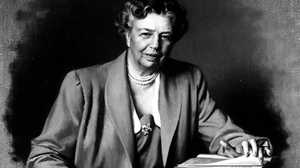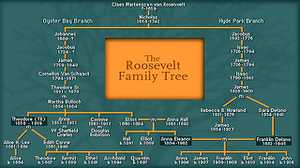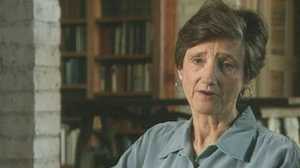Marian Anderson: Musical Icon

Anderson was born in 1897 in South Philadelphia. Hard-working and respectable, her mother was a former schoolteacher. Her father delivered ice and coal throughout the city. At the heart of their community stood the Union Baptist Church at the corner of Fitzwater and Martin Streets. It was within these walls that Marian first began to sing. Her two younger sisters also possessed musical talent, but it was Marian who garnered the most attention. When she was only 14, the choirmaster, Alexander Robinson, moved her from the youth to the adult choir. She stunned the other members not only with the strength and beauty of her voice, but also with her ability to sing any part of a hymn upon demand. Whether it was the soprano, alto, tenor, or bass part that Robinson needed, he could rely on Marian to provide it.
The congregation had such faith in her that they started a "Marian Anderson's Future Fund," which would pay for lessons with the city's leading voice instructors and support her performances. The fund would provide Marian with the support she needed after her father's death in 1911. She continued to give concerts while she attended the South Philadelphia High School for Girls, and her teacher, Dr. Lucy Langdon Wilson, arranged for the famed Italian voice master, Giuseppe Boghetti, to hear her. He remembers this first meeting as occurring "at the end of a long hard day, when I was weary of singing and singers, and when a tall calm girl poured out ‘Deep River' in the twilight and made me cry." While Philadelphia conservatories turned Marian away with the refusal, "We don't take colored," she quickly acquired influential fans who would aid her career.
In 1925 Boghetti entered Marian in a contest with 300 other contestants. The winner would make a solo appearance with the New York Philharmonic Symphony Orchestra. Seventeen-year-old Marian auditioned and won. The achievement prompted Boghetti to take her to Europe. Training and performing, Marian made her European debut at the Paris Opera House in 1935.

The success she met with there made her the toast of Europe, entertaining in command performances before King Gustav in Stockholm and King Christian in Copenhagen. As a young black woman from South Philadelphia who could superbly deliver Russian folk songs, classic German and French arias as well as Negro Spirituals, she was a wonder and people flocked to hear her. Sibelius, the Finnish composer, was so inspired that he dedicated the song, "Solitude," to her. The success she encountered in Europe brought her back to America in 1935 for a public debut at Carnegie Hall in New York. The day before the performance, while still on the Ile de France, Marian fell and broke her ankle. Determined to make her appearance, she performed the entire program standing on one foot, balancing against the piano, with her floor-length gown covering the cast on her ankle. Again, she met with success. It won her so much exposure and popularity that in 1936 she became the first African American to be invited to perform at the White House and then sang there again when Franklin and Eleanor Roosevelt were entertaining the King and Queen of Great Britain in 1939.
Despite the fact that she was the country's third highest concert box office draw, Marian was still subject to the racial bias of the time. When she traveled in the United States, she was often, like all African Americans of her time, restricted to "colored" waiting rooms, hotels, and train cars. In once instance, she was allowed to stay in an upscale Los Angeles hotel, but not to enter its formal dining room. She learned to avoid these affronts by staying with friends in the cities where she performed and driving her own car instead of taking the train. When she performed in the South, despite a general acceptance by the public, the newspapers could not bring themselves to refer to her as "Miss Anderson." The Southern press came up with other forms of address in order to avoid paying her any type of deference; "Artist Anderson" and "Singer Anderson" frequently being used. This type of treatment was symptomatic of the pervasive racism of the time. It finally came to a head in 1939 when Marian's manager, Sol Hurok, and Howard University tried to secure a performance for her at Constitution Hall in Washington D.C. The Daughters of the American Revolution, who owned the Hall, refused to accommodate Anderson. The rebuff was widely publicized when Eleanor Roosevelt, herself a member of the D.A.R., publicly resigned from the organization in protest. In her letter to the D.A.R., she wrote, "I am in complete disagreement with the attitude taken in refusing Constitution Hall to a great artist . . . You had an opportunity to lead in an enlightened way and it seems to me that your organization has failed." Outraged, the "Marian Anderson Committee" formed to petition the D.A.R. and likened the organization's action to those of Hitler's racist regime.

In response, Eleanor and the Committee arranged for Marian to give her concert on the steps of the Lincoln Memorial with the Mall of Washington as her auditorium. Symbolically, the concert took place on Easter Sunday, April 9, 1939. The sun was shining as 75,000 people of all races crowded together; the largest gathering to assemble there since Lindbergh's reception in 1927. Feeling the meaning of the occasion, Marian had tears in her eyes when she delivered "Nobody Knows the Trouble I've Seen" and "America" with heart-breaking pathos. The event was so momentous and inspiring that the D.A.R. finally invited Marian to sing at the Hall in 1943 for a war relief concert. At that event, both black and white concert-goers attended. Marian's awards were many. In 1938 Eleanor Roosevelt presented her with the NAACP's Spingarn Award for "that American Negro who has made the highest achievement in any honorable field of endeavor." In 1941 she was granted the Edward Bok Award for distinguished service to the city of Philadelphia. A key moment in her career came in 1955 when she became the first African American to perform at the Metropolitan Opera. Three years after this immense achievement President Eisenhower named her a delegate to the 13th General Assembly of the United Nations. Over two dozen universities presented her with honorary doctorates and in 1963 President Lyndon Johnson awarded her the Presidential Medal of Freedom.
In 1965 Marian gave her final performance at Carnegie Hall in New York. Afterward, she settled with her husband, Orpheus Fisher, on a farm in Connecticut. She died of congestive heart failure on April 8, 1993. The following June, a memorial service attended by 2,000 admirers paid tribute to the singer whose beautiful voice exposed the country's ugly racial divisions. The singer who had once been barred from performing in the nation's capital and who had been forced to use the back entrance at posh hotels had become an American musical icon.







